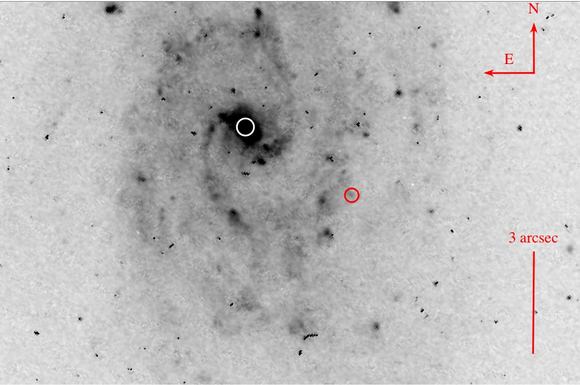Supermassive black holes are thought to lie at the center of most large galaxies. But off in a distant remote galaxy, astronomers have possibly found a giant black hole that appears to be in the process of being expelled from the galaxy at high speed. This newly-discovered object was found by Marianne Heida, a student at Utrecht University in the Netherlands, and confirmed by an international team of astronomers who say the black hole was likely kicked out of its galaxy as a result of the merger of two smaller black holes.
Heida discovered the bizarre object, called CXO J122518.6+144545 during her final undergraduate project while doing research at the SRON Netherlands Institute for SpaceResearch. To make the discovery she had to compare hundreds of thousands of X-ray sources, picked up by chance, with the positions of millions of galaxies. X-rays are also able to penetrate the dust and gas that surround black holes, with the bright source appearing as a starlike point. This object was very bright; however, it wasn't at the center of a galaxy.
Heida discovered the bizarre object, called CXO J122518.6+144545 during her final undergraduate project while doing research at the SRON Netherlands Institute for SpaceResearch. To make the discovery she had to compare hundreds of thousands of X-ray sources, picked up by chance, with the positions of millions of galaxies. X-rays are also able to penetrate the dust and gas that surround black holes, with the bright source appearing as a starlike point. This object was very bright; however, it wasn't at the center of a galaxy.
Super-massive black holes easily weigh more than 1 billion times the mass of the sun. So how could such a heavy object be hurled away from the galaxy at such high speeds? Astronomers say the expulsion can take place under special conditions when two black holes merge. The merger process creates a new black hole, and supercomputer models suggest that the larger black hole that results is shot out away at high speed, depending on the direction and speed in which the two black holes rotate before their collision.
And, the team of astronomers say, there could be more of these "recoiling" black holes out there. "We have found even more of this strange class of X-ray sources," said Heida. "However, for these objects we first of all need accurate measurements from NASA's Chandra satellite to pinpoint them more precisely."
If this object is not a recoiling black hole, other possibilities are that it could possibly be either a very blue type IIn supernova or a ULX (ultra-luminous X-ray source) with a very bright optical counterpart.
Finding more of these expelled black holes will provide a better understanding of the characteristics of black holes before they merge. In the future, astronomers hope to even observe this process with the planned LISA satellite, which will be able to measure the gravity waves that the two merging black holes emit. Further research will provide more insight into how supermassive black holes are created.
Sources: SRON, Royal Astronomical Society

No comments:
Post a Comment